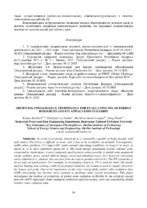Artificial intelligence technology for evaluating solar energy resources and its application in harbin
Bibliographic entry
Artificial intelligence technology for evaluating solar energy resources and its application in harbin / Raman Kulinich [и др.] // Новые горизонты - 2020 : сборник материалов VII Белорусско-Китайского молодежного инновационного форума, 17 ноября 2020 года / Белорусский национальный технический университет. – Минск : БНТУ, 2020. – Т. 1. – С. 50-53.
Abstract
In terms of economy, electricity is a commodity capable of being bought, sold and traded. Electricity is difficult to store, and it has to be available on demand. Consequently, unlike other products, it’s impossible, under normal operating conditions, to keep it in stock, to ration it, or to have customers queue for it. The solar energy generating system, whether gridconnected or stand-alone, is most commonly used in places when possible to install solar equipment (roofs, pollutes areas, closed rubbish dumps, rural and suburban areas). It is based on converting solar radiation (i.e., photons that are sent from the sun) to produce electricity. The PV system has a lot of ways of applications. For example, in developing countries, PV is used for basic life needs, such as heating and cooking, while in developed countries, the system is used to supply electricity for homes and grids. Due to its importance in the solar energy field, global solar radiation data (GSR) forecasting has become more popular to facilitate solar system installation. This paper investigates the method of prediction of global solar radiation in Harbin by the artificial neural network (ANN) approach. Solar radiation prediction and forecasting carry out considering global weather solar radiation data.

